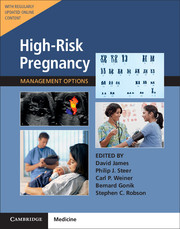Book contents
- Frontmatter
- Contents
- List of Contributors
- Preface
- Section 1 Prepregnancy Problems
- Section 2 Early Prenatal Problems
- Section 3 Late Prenatal – Fetal Problems
- 9 Prenatal Fetal Surveillance
- 10 Fetal Growth Disorders
- 11 Disorders of Amniotic Fluid
- 12 Fetal Hemolytic Disease
- 13 Fetal Thrombocytopenia
- 14 Fetal Cardiac Arrhythmias
- 15 Fetal Cardiac Abnormalities
- 16 Fetal Craniospinal and Facial Abnormalities
- 17 Fetal Genitourinary Abnormalities
- 18 Fetal Gastrointestinal and Abdominal Abnormalities
- 19 Fetal Skeletal Abnormalities
- 20 Fetal Tumors
- 21 Fetal Hydrops
- 22 Fetal Death
- Section 4 Problems Associated with Infection
- Section 5 Late Pregnancy – Maternal Problems
- Section 6 Late Prenatal – Obstetric Problems
- Section 7 Postnatal Problems
- Section 8 Normal Values
- Index
10 - Fetal Growth Disorders
from Section 3 - Late Prenatal – Fetal Problems
- Frontmatter
- Contents
- List of Contributors
- Preface
- Section 1 Prepregnancy Problems
- Section 2 Early Prenatal Problems
- Section 3 Late Prenatal – Fetal Problems
- 9 Prenatal Fetal Surveillance
- 10 Fetal Growth Disorders
- 11 Disorders of Amniotic Fluid
- 12 Fetal Hemolytic Disease
- 13 Fetal Thrombocytopenia
- 14 Fetal Cardiac Arrhythmias
- 15 Fetal Cardiac Abnormalities
- 16 Fetal Craniospinal and Facial Abnormalities
- 17 Fetal Genitourinary Abnormalities
- 18 Fetal Gastrointestinal and Abdominal Abnormalities
- 19 Fetal Skeletal Abnormalities
- 20 Fetal Tumors
- 21 Fetal Hydrops
- 22 Fetal Death
- Section 4 Problems Associated with Infection
- Section 5 Late Pregnancy – Maternal Problems
- Section 6 Late Prenatal – Obstetric Problems
- Section 7 Postnatal Problems
- Section 8 Normal Values
- Index
Summary
Introduction
Disturbance of normal fetal growth can result in abnormal weight, body mass, or body proportion at birth. The two principal fetal growth disorders are fetal growth restriction (FGR) (also known as intrauterine growth restriction, IUGR) and macrosomia, both of which are associated with increased perinatal mortality and short- and long-term morbidity. Perinatal detection of fetal growth disorders has evolved dramatically since the late 1960s, when fetal growth was defined by birth weight before antenatal ultrasound assessment of fetal growth was clinically available. The absolute birth weight was classified as either macrosomia (> 4000 g), low birth weight, very low birth weight, or extremely low birth weight (< 2500 g, < 1500 g, and < 1000 g, respectively). The landmark observations of Lubchenco and colleagues in 1963 showed that the classification of neonates by birth-weight percentile had a significant prognostic advantage because it improved the detection of neonates with FGR and who are at increased risk for adverse health events throughout life. Neonates are now classified as very small for gestational age (< 3rd percentile), small for gestational age (< 10th percentile), appropriate for gestational age (10th–90th percentile), or large for gestational age (>90th percentile). With the development of reference ranges for fetal measurements and the study of their growth rates with advancing gestation, it became possible to apply the concept of growth percentiles prenatally. Subsequently, it became possible to relate absolute and serial fetal measurements to their gestational age-specific percentiles in order to diagnose abnormal fetal size and growth velocity. The detection of a fetal growth disorder is further enhanced if the reference ranges for fetal biometric data and birth weight account for maternal height and race and fetal birth order and sex (growth potential). A neonate may be of normal weight but still significantly lighter than its growth potential. Growth potential percentiles are superior to conventional reference ranges for the prediction of adverse perinatal outcome.
The detection of abnormal body mass or proportions is based on anthropometric measurements and ratios that are relatively independent of sex, race, and to a certain extent gestational age. The ponderal index ([birth weight (g)/crown–heel length3] X 100) is one tool that has high accuracy for the identification of FGR and macrosomia, independent of the birthweight percentile.
- Type
- Chapter
- Information
- High-Risk Pregnancy: Management OptionsFive-Year Institutional Subscription with Online Updates, pp. 226 - 268Publisher: Cambridge University PressFirst published in: 2017



